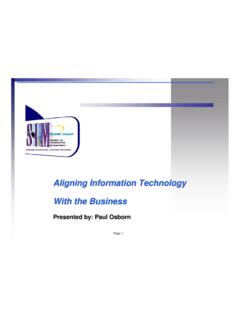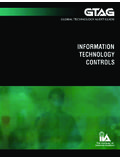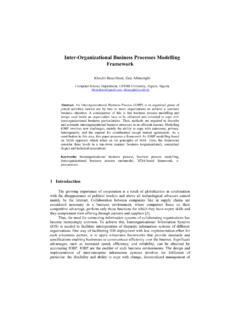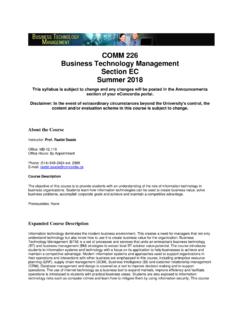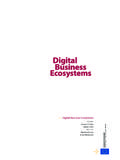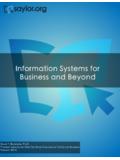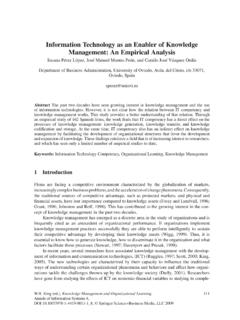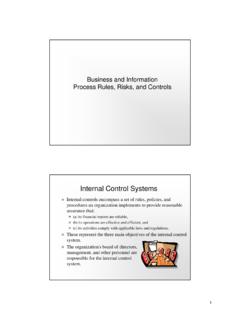Transcription of Information Technology Annual Report
1 Information Technology Annual Report For the year 2014 Table of Contents Introduction .. 1 Executive Summary .. 2 Dashboard .. 3 Scorecard .. 4 Key Initiative Summary for 2014 .. 5 Detailed Performance Analysis .. 6 Divisional Analysis .. 20 2015 and Beyond .. 22 Page 1 of 24 City of Guelph Information Technology 2014 Annual Report Introduction Vision: To transform the Information Technology Department from a solid utility to a partner player aligned with the business needs of the organization. Mission Statement Enabling City departments to provide better service to the public through Technology service and innovation Organizational Structure (Effective December 2014) Previous Years 2014 Target Page 2 of 24 City of Guelph Information Technology 2014 Annual Report Executive Summary Prelude This is the fourth detailed IT Annual Report that also shows a summary of the previous three years.
2 Its intent is to provide a snapshot of current progress, indicate positive or negative trends within key performance areas, and introduce new concepts for future direction on investment and use of Technology . The Report utilizes a number of sources to support the performance ratings including Industry Standards, Municipal Comparators, Best Practices, Maturity Models, and Previous Ratings. The Dashboard visualizes overall performance with the use of intuitive gauges and a colour-coded table. Each gauge indicates the average performance of 18 KPIs (Key Performance Indicators). The previous three years performance has been provided for comparison. The table organizes the KPIs into four main categories; IT Governance, IT Service Delivery, IT Sustainability, and IT Innovation & Learning.
3 These categories closely match the four pillars of the CTSP (Corporate Technology Strategic Plan). The Scorecard adds more detail, including targets set for the future year. This is where you will see how the KPI is rated; as a level of maturity or as a percentage. Results Based on the results provided in the Report s dashboard, the IT function at the City of Guelph has progressed from a Solid Utility to a Trusted Supplier . The improvements made in the delivery of projects, on-time and within budget, contributed to this designation. Positive results from the Customer Satisfaction Survey were also a major success factor. The department is well positioned to achieving its vision of becoming a Partner Player (Enabler of Technology ), contributing to the success of all departments.
4 The Transformation of IT Becoming a Partner Player is the principle vision for IT. The transition to becoming an enabler of business is much more than simply providing each business unit with the Technology they have scoped to enhance service levels and performance. At present, Technology has the potential to drive business strategy. This means that IT must evolve from its current Trusted Supplier state to become an innovative catalyst within the City. IT must transition from serving primarily as an operator or as a provider of Technology to play an envisioning role for the organization. This change will require a realignment of resources and a commitment to organizational leadership. There must also be a willingness and ability to adapt to ongoing change as well embrace and respond to risks associated with innovation.
5 In short, IT must play four distinct roles within the organization explore, engage, enable and evangelize. As the illustration suggests, the transformation from a doing to a thinking IT requires a wholesale change to the legacy form and function of the department. The structure and skills within IT must be variable in order to maximize resources and positioned in such a way that they support the overall business. The culture of IT as an operator cannot be lost entirely, however, it must also provide effective leadership and an ability to support the transformation of the business. The concept of bimodal IT, provides for this balance aspects of IT remain as a Solid Utility , while others focus on adaptation and innovation.
6 For IT to fully evolve into a thinking role, work must continue to augment several of the key performance indicators below. In 2015, a continuous improvement process will be established to ensure that the recommendations made in this Report are tracked by way of an improvement register. This further commitment to ongoing performance management is a key to IT transformation. A functional realignment of the department will also take place in order to better align skills and resources. The transformation of IT will be an ongoing journey as a result of the environment being in a continual state of flux. IT, like the City at large, must constantly assess how best it can provide the maximum value to its customers and stakeholders, and transform itself to deliver this increased value.
7 Page 3 of 24 City of Guelph Information Technology 2014 Annual Report Information Technology Dashboard As illustrated below by the Information Technology Dashboard, several KPIs (Key Performance Indicators) have been aligned into four categories to illustrate progress toward achieving the performance goals of the department. Items in the dashboard marked by GREEN indicate that the City of Guelph is reporting metrics that compare positively to industry standards. YELLOW and RED indicate items that are not currently in line with industry standards. PLUS and MINUS signs indicate the direction that these indicators are trending. IT Governance 2011 2012 2013 2014 IT Service Delivery 2011 2012 2013 2014 Strategic Alignment + + Customer Satisfaction + + Business Value Delivery + Customer Engagement + + Risk Management + - IT Process Management + Resource Management + Infrastructure Availability Performance Measurement + IT Sustainability 2011 2012 2013 2014 IT Innovation & Learning 2011 2012 2013 2014 Applications Management Workforce Competency + Project Performance - + Strategic Technology Adoption Financial Management + + Methodology Adoption Compliance - Employee Retention + + + Total Cost of Ownership (new KPI in 2013)
8 Information Technology Dashboard 2014 Page 4 of 24 City of Guelph Information Technology 2014 Annual Report Information Technology Scorecard Governance Measure 2014 Target 2014 Result 2015 Target Strategic Alignment Maturity Level 3 Maintained Level 2, CTSP requires review and updating Maturity Level 3 Business Value Delivery Maturity Level 3 Achieved Level 2 (Basic), Business Value is evident but not tracked, require KPIs for both IT and business units Maturity Level 3 Risk Management Maturity Level 3 Maintained Level 2 (Developing), no IT Risk Manager, Risk Register requires updating Maturity Level 3 Resource Management Maturity Level 2 Exceeded the target and achieved Level 3 (Governed Capacity) for resource management Maturity Level 3 Performance Measurement Maturity Level 2 Achieved Level 1 (Beginner) , identified more divisional KPIs, refined Annual Report , requires more focus on monitoring and analysis to move to a higher level Maturity Level 2 Service Delivery Measure 2014 Target 2014 Result 2015 Target Customer Satisfaction 80% Exceeded target, of all support calls completed within target times, FCR (First Call Resolution)
9 Was at which is a 13% improvement over 2013 85% Customer Engagement Maturity Level 2 Maintained Level 2 (Progressive), collaborated with General Managers on their workplans and future strategic directions Maturity Level 3 IT Process Management Maturity Level 2 Maintained Level 2 (Repeatable) requires identification of process owners and comprehensive review of COBIT 5 processes. Maturity Level 3 Infrastructure Availability Achieved an average availability of , most downtime was from areas outside the department s control. Sustainability Measure 2014 Target 2014 Result 2015 Target Applications Management Maturity Level 3 Achieved target of Level 3 (Mature), completed major application assessments, reorganized Corporate Applications Division, plan to follow CTSP recommendations Maturity Level 3 Project Performance 100% 99% of initial intake meetings were scheduled within 2 business days of submitting the request.
10 100% Financial Management Maturity Level 3 Achieved target of Level 3 (Defined), .8% variance on a operating budget Maturity Level 3 Compliance Maturity Level 3 Did not meet target of Level 3 (Defined), a Compliance Manager needs to be appointed with a mandate to define external & internal compliance requirements Maturity Level 3 Total Cost of Ownership Maturity Level 3 Did not meet target, limited progress, most calculations are basic and manually performed Maturity Level 3 IT Innovation & Learning Measure 2014 Target 2014 Result 2015 Target Workforce Competency Maturity Level 3 Maintained Level 3 (Defined), identified skills gap to support business needs, no P-CMM (People Capability Maturity Model)






